The erection of the base is a mandatory stage in the installation of various structures. The foundation for the veranda is built according to general rules, but there are some features of the choice of type and materials. Much depends on the nature of the future building.
The need and features of the foundation for the veranda
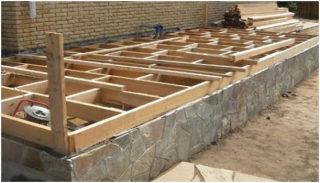
Compared to the house, the veranda is lightweight, but it still creates a load on the ground, causing soil subsidence. The foundation partially solves this problem and performs important functions:
- takes the weight of the building and distributes it;
- holds the structure at the level of the house;
- protects against heaving and ground movement;
- protects against moisture.
When choosing the type of foundation, one should start from the material from which the construction will be made, the weight of the structure, and the characteristics of the soil.
To avoid problems after the completion of construction, the foundation for the veranda should be made the same depth as for the house - below the depth of soil freezing. However, in practice, they often build a shallow one in order to save on materials and reduce labor costs. In this case, it is recommended to choose a structure that better resists soil deformation.
A freshly made base can be especially strong after winter. Therefore, it is not worthwhile to rigidly tie the base of the house and the terrace in the first couple of years. Leave a gap of 20-40 cm (technological joint) and remove the ends of the reinforcement from both foundations.
Materials and tools

Of the tools you need:
- a shovel, a concrete mixer, a mixing container - all this will be required to prepare concrete or cement mortar;
- welding machine, grinder, pliers - needed to fit metal pipes, create a reinforcing cage;
- drill, nail puller, screwdriver, saw, hammer - will be required for the construction of the formwork;
- a tape measure is required for marking.
A set of materials for building a foundation includes:
- cement;
- sand;
- crushed stone or gravel;
- wire;
- fittings;
- roofing material;
- stakes;
- ropes;
- nails.
The main material can be PVC or metal pipes, bricks, boards or plywood, cinder blocks, foam blocks.
Types of foundations for the veranda
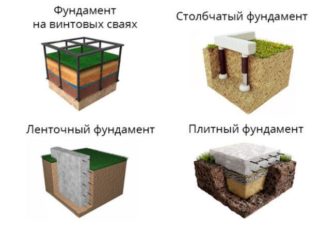
There are several types of foundations that are more or less suitable for the construction of a veranda.
Columnar
Columnar foundations are used for light structures and soils with good bearing capacity. The veranda is most often erected on this basis. Supports-pillars can be made of cinder blocks, bricks, metal pipes, reinforced concrete. The final cost of concrete deck support pillars is one of the most beneficial. Brick pillars are more expensive because solid fired bricks are recommended.
Tape
For light construction, a foundation buried by 0.5-0.7 m is enough. Concrete tape is reliable and versatile, but it is poorly suited for swampy soils, areas where groundwater is located close to the surface. But even then, you can build reinforced options.
Screw
The screw foundation is optimal for heaving, swampy soils. At the same time, it is not suitable for rocky soils due to the nature of the installation. There is no need to prepare deep pile holes. There is a screw at the lower end of the support, and it is screwed into the soil, cutting through its layers. This is a complex and expensive base, but sometimes the only one possible.
The screw foundation is installed quickly, without the use of special equipment, at any time of the year. Construction can begin immediately after installation.
The pile diameter is selected in accordance with the future load. For an easy extension, screw piles with a diameter of 76 and 89 cm are suitable.
The screw foundation for the veranda cannot be installed closer than half a meter from the house, due to the use of special levers.
From the pipes
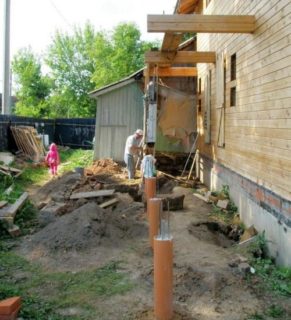
When building a columnar foundation, it is convenient to use pipes made of various materials. The role of permanent formwork is played by products made of PVC, asbestos cement, metal. This is an economical option for a terrace base. In addition, in the case of PVC and asbestos cement, the formwork does not corrode. The disadvantages of pillars for a veranda are a relatively short service life - up to 50 years and the ability to use only for light buildings.
From FBS blocks
The foundation of FBS blocks can be arranged even on difficult sandy soils. Such a base will withstand a brick building, but the blocks absorb water, therefore, they require careful waterproofing. Considering cost and labor, they are not suitable for outbuildings. The construction of the foundation from the FBS involves the use of special equipment.
Stone
The stone foundation is made of quarrystone - a stone of natural origin. It is durable, moisture resistant and has an acceptable cost. The stone has increased strength and can withstand significant loads. An important disadvantage: masonry work is complicated by the need to adjust the rubble stone to size. For the construction of the foundation, you need to select clean material and test it for strength with a hammer.
On piles
The main difference between a pile foundation and a columnar foundation is that the supports are buried to the ground with sufficient bearing capacity. In some cases, their length may exceed 5 m. An element of the pile-grillage structure is a pile, which is buried in the ground, and then they are connected to each other by a concrete grillage. The main advantage is that the pile foundation shows itself perfectly in any conditions: soil that is prone to subsidence. However, its construction is associated with significant labor costs.
Concrete slab
There is a possibility of building such a foundation for the veranda, but it is not profitable due to the high consumption of materials, the need for insulation, which, in general, makes pouring a concrete slab inappropriate.
Construction of the foundation for the veranda with your own hands
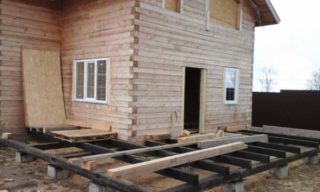
The construction of any type of foundation includes a number of successive stages. If you do not consider each type separately, the process consists in marking, earthworks: digging a trench or foundation pits. Further, the types of work will differ depending on the type of base. For example, if a veranda on screw piles is attached to the house with your own hands, the heads need to be welded to the supports.
Columnar
For a small veranda, 4-6 supports are enough. They are installed at a distance of no more than 1.5-2 m from each other.
- At the location of the pillars, stakes are driven in, and then holes are dug below the depth of freezing of the soil to the size of the so-called heel of the pillar - the broadening at the bottom.
- They make a sand pillow: they pour about 15–20 cm of sand. They ram it down.
- A frame is built from the reinforcement, fastened with a knitting wire.
- Formwork for pillars is made of wooden boards or roofing material. Wooden formwork is used for the construction of square pillars, roofing felt - round.
- The reinforcement is placed inside the formwork and a cement mortar is poured, mixed from cement, sand and crushed stone in a ratio of 1/3/5. It is recommended to fill it gradually, at the same time pouring in the soil from the outside so that the roofing material does not break.
If the columnar foundation is made of concrete blocks or bricks, the sequence of work remains the same, only the blocks are laid on the level and after the end of the masonry, the pillars must be waterproofed. This type of foundation is optimal for a veranda made using frame technology.
Tape
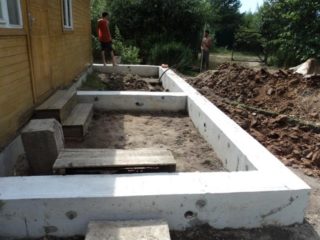
It is advisable to make a strip foundation if the veranda will be built from heavy materials: brick, foam concrete.
Step-by-step instructions for performing work:
- The place for the foundation is cleared and a trench is dug around the perimeter. Its depth depends on the type of soil: if the soil is clayey, the depth should be about 1.5 m, if it is sandy, 30 cm is enough. The width of the trench should be 20-30 cm more than the width of future walls plus 5-10 cm additionally.
- At the bottom of the trench, a sand cushion about 10-15 cm thick is set up and carefully compacted.
- Formwork is made from plywood sheets, boards or other materials at hand. It should lift about 30 cm above ground level. Wooden stakes are used as props.
- The frame is tied from the reinforcement with a thickness of about 1 cm and laid in a trench.
- The foundation is poured with concrete.
The concrete foundation gains strength for at least two weeks, only after that the building can be erected.
Pile
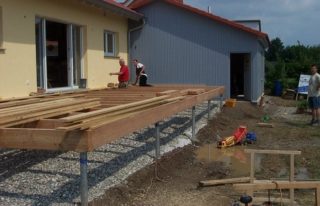
The addition of a veranda on stilts to the house is quite easy:
- Preparation for construction includes the removal of the fertile layer - about 20 cm of soil. If the soil is clayey, first pour 10 cm of sand, and then 10 cm of crushed stone.
- It is recommended to install piles at a distance of no more than 2-2.5 m. Before installation, holes are drilled in the ground with a depth of at least 1.5 m.
- Install asbestos-cement pipes into the holes.
- A frame made of 1.2 cm reinforcement is placed in them, fastened across with thinner rods.
- Then, the grillage formwork is installed according to the type of strip foundation, airflows are made, fixing the pipes across the formwork and the reinforcement cage for the grillage along. Concrete is poured.
Compared to the strip foundation for the veranda, the pile foundation is more profitable from an economic point of view.
Screw
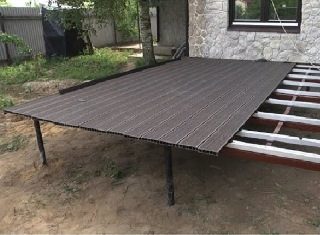
The screw foundation is installed in the following order:
- Preparation of the territory is not required, therefore, they immediately begin to mark the territory with pegs, which will indicate the place of installation of the piles. The distance between them should be about one and a half meters.
- The piles are screwed in so that about 50 cm remains on the surface.As they are installed, they are leveled to a single level, for example, using a laser level.
- Cut with a grinder to the required level.
- Concrete is poured inside to prevent metal corrosion.
- Heads are welded to the upper part of the supports, onto which a strapping bar, channel or grillage are then fixed.
The base is not subject to the forces of frost heaving and is repairable.
You cannot unscrew the pile for alignment - then it will sag.
Stone
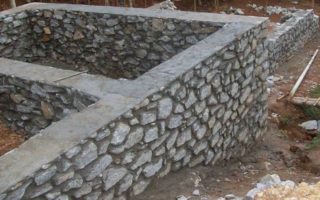
Before erecting the base, large blocks should be split into pieces of 25-30 kg using a hammer and chisel according to the markings.
- Construction begins with digging a trench. It is dug below the freezing depth.
- If formwork is used, its inner surface is protected with roofing material or polyethylene.
- The masonry is reinforced with reinforcement and widening is made at the bottom. You can make a foundation for pouring, then the stones do not need to be sized and you can significantly save time. In this case, the quarry is placed on a sand cushion, the gaps are filled with crushed stone, tamped and then poured with concrete mortar in order.
The above-ground part of the foundation for the terrace can be laid on the mortar to make the surface look neat, or the concrete strip foundation can be poured using formwork, after having previously completed the reinforcement.
From FBS blocks
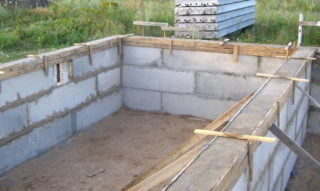
The FBS block foundation is too difficult to build, it is more suitable for heavy buildings. To lay out a block foundation, you first need to dig a trench, then prepare a cushion of sand and rubble, perform waterproofing from roofing material and lay the blocks on a cement mortar. On the sides and on top, they are also waterproofed, you can use a coating waterproofing for this purpose.
When choosing a foundation for a veranda, it is necessary to decide whether a particular option will be profitable and reliable in the given conditions. Each foundation implies completely different construction costs.








